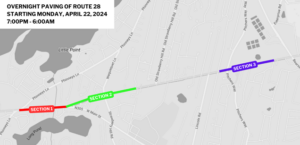FRAMINGHAM, MA – The Massachusetts Emergency Management Agency (MEMA), in coordination with the Massachusetts State Police (MSP), Massachusetts Department of Transportation (MassDOT), and local public safety officials on Cape Cod, may activate the Cape Cod Emergency Traffic Plan (CCETP) as a hurricane or strong tropical storm approaches the region to facilitate the movement of vehicles leaving Cape Cod. Although developed to manage the egress of vehicles from the Cape in advance of a hurricane, this all hazards plan also can be utilized to improve traffic flow off Cape Cod in other emergency situations.
The CCETP is a traffic management plan; it is not an evacuation plan for the Cape. As a hurricane or tropical storm approaches Cape Cod, local officials will consider whether localized evacuations may be necessary and will issue evacuation recommendations or orders, as required. Depending on the strength and track of an approaching storm, local officials may encourage or order people in low-lying, flood-prone areas to evacuate to higher, safer ground. If necessary, regional shelters will be opened on Cape Cod to accommodate evacuees during the storm.
Low-lying, flood prone areas on Cape Cod already have been identified and included within the Commonwealth’s hurricane evacuation zones. To learn whether you work or live in a designated hurricane evacuation zone, go to the interactive Know Your Evacuation Zone<http://www.mass.gov/eopss/agencies/mema/emergencies/hurricanes/hurricane-evacuation-zones.html> map on MEMA’s website. As a hurricane or tropical storm approaches, people in hurricane evacuation zones should monitor news broadcasts and weather forecasts and move to higher ground if an evacuation order is issued.
Even if Cape Cod is threatened by a powerful hurricane, it is extremely unlikely that local or state officials would order an evacuation of the entire Cape. Except for residents of low-lying, flood prone coastal areas, most residents would be safe in their homes or in regional shelters.
Although widespread evacuations off of Cape Cod will not be necessary in advance of a hurricane, many residents and tourists may nonetheless choose to leave the Cape and Islands, particularly if the region is threatened by a strong hurricane. The CCETP is designed to minimize, as much as possible, traffic jams caused by large numbers of vehicle leaving the Cape.
The CCETP was developed following Hurricane Edouard, which approached Cape Cod on Labor Day in 1996. Within hours of the Governor declaring a State of Emergency, a 6 to 8 hour backup of vehicles occurred, stretching an estimated 40 miles, from the Sagamore Bridge to the Orleans Rotary on Route 6.
Once the CCETP is activated, traffic flow patterns and control points are implemented to mitigate the traditional causes of congestion and keep traffic flowing, particularly in the areas of the Bourne and Sagamore Bridges and the Cape’s main arteries – – Routes 6 and 28 – – leading up to the bridges.
“The Cape Cod Emergency Traffic Plan will only work with the full cooperation of the public,” stated Massachusetts Emergency Management Agency Director Kurt Schwartz. “To ensure the safety of individuals and their families, it is imperative that citizens carefully follow the instructions of local and state officials, in a timely, responsible manner. Motorists leaving Cape Cod in advance of a hurricane need to follow traffic directions, and leave well in advance of the storm so that they reach their destination before driving conditions become unsafe.”
The CCETP is implemented in phases. Phase l eliminates off-Cape access to Routes 6 and 28 at the base of both bridges, prohibits local traffic access to these main arteries through the rotaries at the bridges, and prohibits all cross-rotary traffic by implementing detours and road restrictions. The Massachusetts State Police (MSP) will be positioned at these crucial travel points, and information will be shared with the public via MassDOT electronic sign boards and continual media announcements.
Phase 2 of the CCETP is activated when the Army Corps of Engineers, MSP, MassDOT, and MEMA determine that winds have reached or are about to reach dangerous levels, precipitating the closure of all traffic on the Bourne and Sagamore bridges. Past versions of the CCETP tied closure of the bridges to specific wind-speed thresholds. In the most recent Plan, the decision to close the bridges will be based on a variety of additional factors such as the forecast, time of day, and traffic and road conditions. If the bridges are closed, motorists will have the option of seeking shelter in one of Cape Cod’s regional shelters or in a large-capacity shelter that will be opened on Joint Base Cape Cod (formerly Massachusetts Military Reservation) by the American Red Cross, Massachusetts National Guard, and MEMA. The shelter on Joint Base Cape Codwill provide motorists with a safe haven until the storm passes.
The CCETP is managed or supported by numerous agencies, including MEMA, the Massachusetts State Police, MassDOT, MA Department of Public Health, MA National Guard, Coast Guard, Joint Base Cape Cod, US Army Corps of Engineers, American Red Cross, International Fund for Animal Welfare, Cape Cod Medical Reserve Corps, Barnstable County Incident Management Team, Barnstable County Regional Emergency Planning Committee, Barnstable County Sheriff’s Office, Bourne and Sandwich Police Departments, Local Emergency Managers and Public Safety Officials from across the Cape, the Steamship Authority, the National Weather Service, the Cape Cod Chamber of Commerce, Cape Cod CERT, WQRC, and many others.
The latest version of the Cape Cod Emergency Traffic Plan is available through MEMA’s website at http://www.mass.gov/eopss/home-sec-emerg-resp/emergency-response/ccetp/.
Media release furnished by Mass Emergency Management Agency

























Speak Your Mind